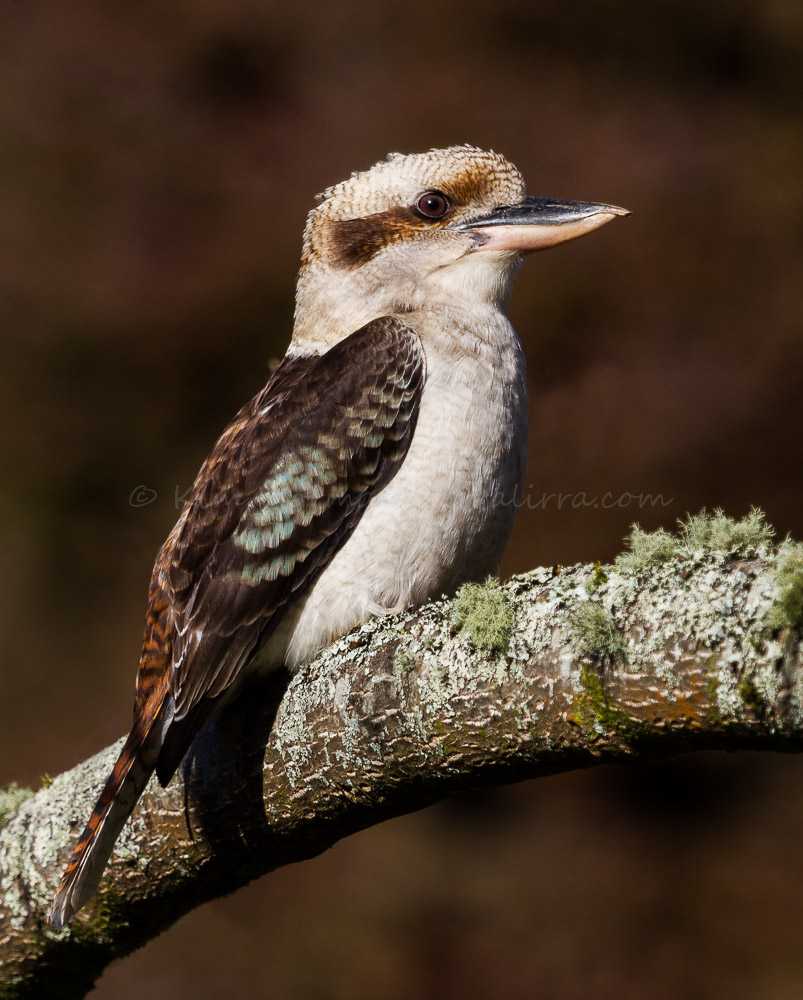For the past couple of weeks I’ve been surrounded by Laughing Kookaburras at home, out walking and today they even turned up when I took a little tacker to the hairdressers – luckily I had my camera with me! Maybe bird photography is an obsession, even as I write I’m watching finches through the window and assessing the lighting.
 Laughing Kookaburra (Dacelo novaeguineae)
Laughing Kookaburra (Dacelo novaeguineae)
Canon 7D, 100-400mm L IS USM, 1/500, f/5.6, ISO 100, focal length 400mm
I was rapt with the beautiful perch that the kooka in the image above chose to land on, the lichen and moss looked lovely in the low morning light, as did the kooka’s feathers and catch-light in its eye. I like its pose as it stares intently at the ground looking for prey. It’s remarkable how far distant a kookaburra can see a likely looking worm, insect or reptile.
 Laughing Kookaburra (Dacelo novaeguinaea)
Laughing Kookaburra (Dacelo novaeguinaea)
Canon 7D, 100-400mm L IS USM, 1/500, f/5.6, ISO 100, focal length 400mm
The image above is another typical kookaburra pose, gazing into the distance before lifting its tail, pooping and flying away. They look heavy in flight, as though their heads are too big to allow them to stay in the air. These large kingfishers (about 40cm and 340g) can be confused with Blue-winged Kookaburras although the two species only overlap in Queensland. Blue-winged Kookaburras are slightly smaller with more blue on their wings, blue rumps and strangely pale eyes.
Even if you’ve never seen a Laughing Kookaburra you have almost certainly heard one as their calls have been used in movies for decades including Tarzan and Indiana Jones. Despite being endemic to Australia, Laughing Kookaburras feature in movies set in African and South American jungles, as well as many other unlikely places.
The kookaburras’ call is fantastic, a long maniacal laugh that echoes around you, especially when several birds are calling together. They often call early in the morning and late in the evening, marking their territories by moving from corner to corner and calling loudly. There’s a good recording of a Laughing Kookaburra on BirdNote although the North American voice-over pronounces kookaburra incorrectly, as do my Canadian friends and family. It’s not k-00-kaburra where the ‘oo’ sound rhymes with ‘two’ but what is referred to as a schwa, or unstressed neutral vowel sound, like the ‘a’ at the end of America. Maybe it would help if it was written as ‘k’kaburra’ but then we’d have one less thing ourselves to chuckle about.
Happy birding, Kim
NB It is now possible to receive a weekly email letting you know that lirralirra has been updated – just add your address to the ‘Subscribe to email’ box above right.
Also, I recently added a Facebook ‘like’ button. Thank you to all ‘likers’ – I like you too!

great shots!
Thank you Glenn!
hoooo, you got it so close, there plenty of details, a pleasure to dicover
it s a specie i never seen before, and it was a very nice luck to meet it just near your home, bravo
have a nice day
I’m glad you like the new species Eric, they are impressive looking birds I think. You have a lovely day too
The are cool birds, I would love to see them in the wild. Great shots and post. Have a great weekend!
I hope you do get to see them in the wild, let me know if you decide to visit. You have a great weekend too!
Hello Kim,
Love the photos, beautiful Kookaburra, you have done him/her justice.
Is it a male or female, I haven’t really thought about that before.
Photography is the best obsession to have, never off my mind either.
You make superb use of your time with the camera.
I’m so glad you like the kookaburra photos. I think it’s possibly a female but the sexes are very similar. Males often have a mottled blue rump while females have a brown rump; this kooka’s rump is very brown. Females’ heads are more buff but I find it hard to call unless a pair are sitting together as in the “Kookaburra sits in the old gum tree” post (which I have tried to link to with no luck) where I think the one on the right is probably the female. It could also be a juvenile, I wish I had HANZAB! Photography is an excellent obsession
The call of a kookaburra, and that of a magpie signify ‘home’ to me. Very different calls, but they both make my heart sing. I agree with you about the perch – it really couldn’t be much better. Wonderful photos – thank you.
And there are many, many worse obsessions that avian photography, or even just birds in all their feathered wonder (says a fellow obsessee).
I know how you feel about those two bird calls EC and you have a beautiful way of expressing it. Thank you for your kind comments, it’s lovely to ‘know’ a fellow obesessee.